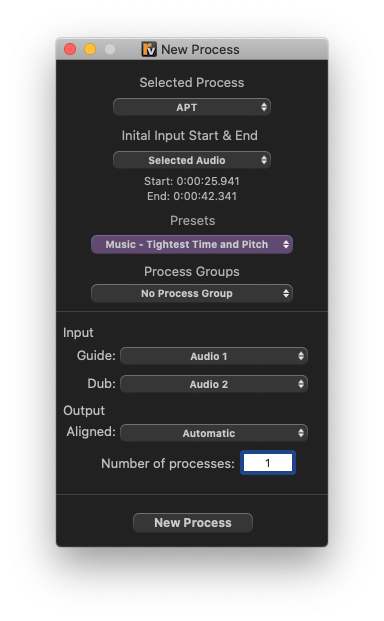Check/change APT settings
If you do not see the New Process window (shown in the image below on the right), then you need to open it. There are two ways to do this.
1) RIGHT CLICK in any Process Control Track and select New APT.
2) Make sure the Revoice Pro session window is selected and press the B key on your keyboard. This will open the New Process window as shown below. LEFT CLICK the Selected Process drop down to select APT. Pressing the B key again will close the window - but it is generally more efficient to leave this window open.
Revoice Pro automatically preselects all of the drop down menu items in the New Process window. We briefly explain each drop down option used in this first example.

Selected Process: is correctly set to be an APT process. (It will be what was previously selected until you change it).
Initial Input Start and End: Selected Audio uses any audio selected and shown in green in a session track, from start to end. Alternative options for drop-down setting this can be found in Setting a Process Control Block.
You could alternatively create a Playback Range to highlight time periods of the audio to be processed, rather than relying on automatically selected audio.
Presets: you can change the APT process settings before creating the process. If nothing is changed, then the current User Default Preset (or, if that's not selected, the Factory Default) will be used. You can choose from one of the provided Factory Presets in the Presets drop-down menu, as a good starting point for processing typical programme material. Here, shown purple, the preset "Music - Tightest Time and Pitch" has been selected. (See Process Presets.)
Process Group: this Process can be made part of a Process Group if required, but "No Process Group" is the default.
Inputs: choose the audio tracks containing Guide and Dub respectively.
Output: choose an audio track for the Aligned (processed) audio to be sent to. Automatic selects the output track for you, creating or using a suitable free track or tracks, and maintains a relationship between input and output tracks even if they are moved. Alternatively, you can manually choose an output track using the drop-down menu.
Number of processes: it is possible to create multiple output tracks from the same Guide, each based on a separate Dub track. This will be explained in a later section.
Related topics:
Changing input and output tracks